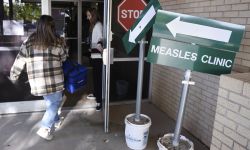How older Michiganders landed in Medicaid plan aimed at family planning

- Michigan last year began checking the eligibility of those who had enrolled in Medicaid during COVID
- About 20,000 MIchiganders were in a narrow band of income in which they no longer qualified for Medicaid, but could still qualify for a trimmed down coverage
- The new plan, which is focused on reproductive health, has no age limit
Jay Allshire is puzzled. He’s just looking for a way to manage his diabetes. So, how did he end up with an insurance policy designed to cover services like pregnancy testing and birth control?
“I’m 65,” he told Bridge. “I’m not running around every night. What the hell do I need that for?”
The Jackson man is one of a small number of Michigan residents who, after losing access to traditional Medicaid, were enrolled in a limited benefit plan Medicaid plan. Problem is, it's focused largely on reproductive health, leaving some patients with little or no coverage for services they need most.
And some of them say they had no idea they’d been enrolled.
The program is called Plan First, and it’s a limited benefit plan.
Unlike most other Medicaid plans that cover a broad range of physical and behavioral health services, Plan First offers benefits focused on reproductive health and family planning. It’s also a fee-for-service model, which means that it isn’t managed by commercial providers, such as Blue Cross Blue Shield of Michigan or HAP.
Related:
- Michigan Medicaid expanded to cover health workers you may not have heard of
- Lifesaving doula services expanding for Michigan moms with help of Medicaid
- Michigan offering free birth control pills, condoms at over 300 locations
It covers, for example, pregnancy testing and counseling, birth control, testing and treatment for sexually transmitted infection, some cancer screenings, sterilization procedures, and medications people take to prevent infection before and after exposure to HIV.
What won’t be covered is a hospitalization like the one Allshire had in 2013, when his toe became so infected that he was put on an IV antibiotic drip and surgeons removed his big toe.
Bills topped $40,000, he said, but picking up the tab was Medicaid. He’d qualified for the state’s safety net insurance plan after losing his job in 2008 when the internet provider service he worked for closed, he said.
When Allshire went back to his doctor’s office recently to hook up a remote pulse oximeter device to his tablet, he found he’d been enrolled in Plan First.
“I was ‘Are you kidding me?’” he said.
Allshire said Plan First makes sense for a younger person who can make more use of it. He needs insurance to cover costs related to his diabetes care, for example.
Don Knox, practice administrator of Pulmonary Clinics of Southern Michigan. said he had a list in his hand of nine patients who were enrolled in Plan First without their knowledge.
“It’s a huge disruption” for care when they show up for an appointment and suddenly confront bills that they can’t afford, Knox said.
Some hospital patients also have been confused, according to anecdotes reported to the Michigan Health & Hospital Association, spokesperson John Karasinski told Bridge Monday.
How patients got in
People who were enrolled in Plan First were notified by mail, Lynn Sutfin, spokesperson for the Michigan Department of Health and Human Services, said in an email to Bridge.
The plan launched in September, 2023, as the state was reevaluating eligibility for some 3 million Michiganders who had been covered by Medicaid during the pandemic. At the close of the year-long redetermination late this summer, just more than 1.6 million remained on Medicaid, according to the Michigan Department of Human Services.
To be clear, only Michigan residents who fall within a very narrow income band qualify for Plan First. They are the estimated 20,000 whose income grew enough during COVID that they were no longer eligible for Medicaid, but whose income is at or below 200% of the federal poverty level (about $30,120 for a single person this year).
The state reviews applicants’ income and nonfinancial information, such as their age and disability, and enrolls them in the plan for which they qualify, said Sutfin, the department spokesperson.
Plan First allows them at least some coverage, albeit limited. For example, it covers some vaccines and cancer screenings.
It aligns with Gov. Gretchen Whitmer’s campaign to make reproductive health more accessible. In 2022, Whitmer helped push Prop 3, which enshrined abortion as a state constitutional right. (Plan First doesn’t cover abortion services.)
And this fall, her administration launched Take Control of Your Birth Control, which made available over-the-counter oral birth control pills, emergency contraception, condoms, and family planning resources in health centers throughout the state this month.
No age, gender limits
Plan First is a new version of a program that the state phased out by 2016. By that time, the Affordable Care Act had allowed the expansion of Medicaid in Michigan and the establishment of low-cost insurance plans on the federal Marketplace (www.healthcare.gov).
The previous Plan First program was limited to women ages 19 to 44; the new plan drops but both age and gender restrictions.
That means some beneficiaries were “dual-eligibles” — old enough for Medicare. Those beneficiaries then receive coverage from both Medicaid and Medicare, Knox, the practice manager, told Bridge Tuesday.
“What does a 75-year-old woman need with this plan?” he said.
More than 25% of the services have been provided to individuals 60 and older, Sutfin told Bridge.
See what new members are saying about why they donated to Bridge Michigan:
- “In order for this information to be accurate and unbiased it must be underwritten by its readers, not by special interests.” - Larry S.
- “Not many other media sources report on the topics Bridge does.” - Susan B.
- “Your journalism is outstanding and rare these days.” - Mark S.
If you want to ensure the future of nonpartisan, nonprofit Michigan journalism, please become a member today. You, too, will be asked why you donated and maybe we'll feature your quote next time!








